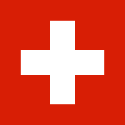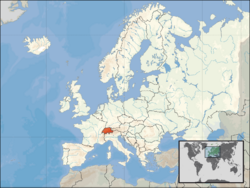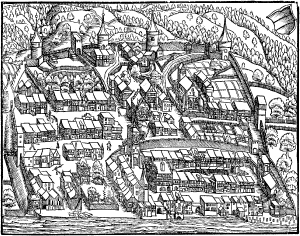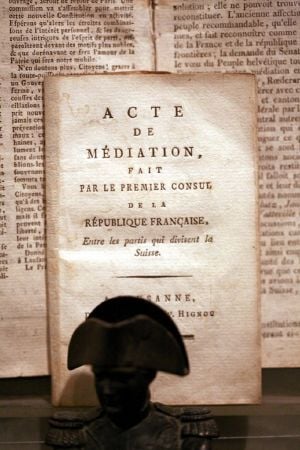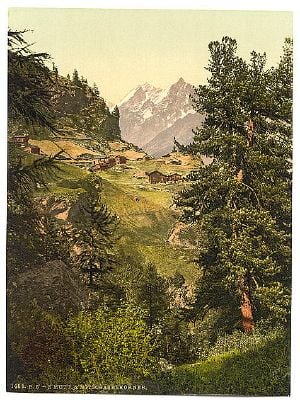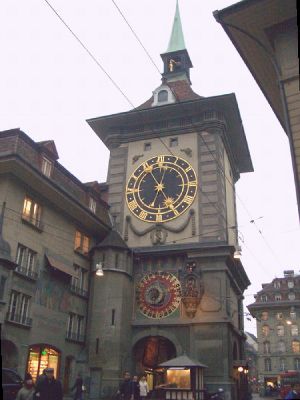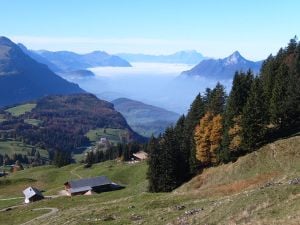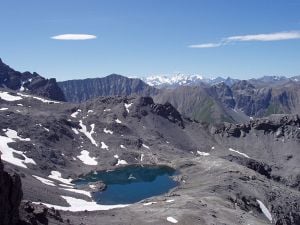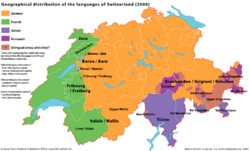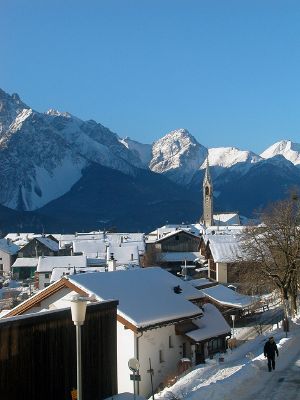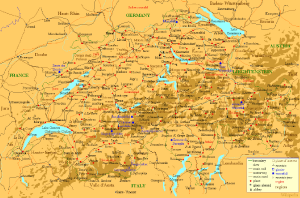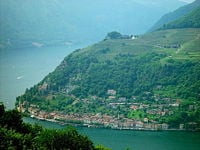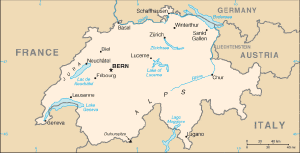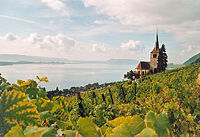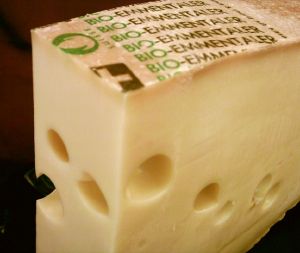Difference between revisions of "Switzerland" - New World Encyclopedia
(Wanted) |
Keisuke Noda (talk | contribs) (import from wiki) |
||
| Line 1: | Line 1: | ||
| + | {{claimed}} | ||
| + | {{dablink|"Swiss" redirects here. For other uses, see [[Swiss (disambiguation)]] and [[Switzerland (disambiguation)]].}} | ||
| + | {{Infobox Country | ||
| + | |native_name = {{lang|la|''Confoederatio Helvetica''}}<br/>{{lang|de|''Schweizerische Eidgenossenschaft''}}<br/>{{lang|fr|''Confédération suisse''}}<br/>{{lang|it|''Confederazione Svizzera''}}<br/>{{lang|rm|''Confederaziun svizra''}} | ||
| + | |conventional_long_name = Swiss Confederation | ||
| + | |common_name = Switzerland | ||
| + | |image_flag = Flag of Switzerland.svg | ||
| + | |image_coat = Coat of Arms of Switzerland.svg | ||
| + | |image_map = Europe location CHE.png | ||
| + | |map_caption = {{map_caption |region=on the [[Europe|European continent]]}} | ||
| + | |national_motto = {{lang|la|''[[Unus pro omnibus, omnes pro uno]]''}}<!--IF YOU FEEL TEMPTED TO REPLACE THIS WITH "none", PLEASE CHECK THE TALK PAGE AND ITS ARCHIVES FIRST, and also read the linked article!--> <small>([[Latin]]) (traditional)<ref>The motto is traditional; it is not officially defined by the Swiss constitution or Swiss law. See {{lang|la|[[Unus pro omnibus, omnes pro uno]]}} for more information.</ref><br/>"One for all, all for one"</small> | ||
| + | |national_anthem = [[Swiss Psalm]] | ||
| + | |official_languages = <span style="line-height:1.25em;">[[German language|German]], [[French language|French]], [[Italian language|Italian]], [[Romansh]]<ref>[http://www.oefre.unibe.ch/law/icl/sz00000_.html Switzerland Constitution], article 70, "Languages": (1) The official languages of the Federation are German, French, and Italian. Romansh is an official language for communicating with persons of Romansh language. (2) The Cantons designate their own official languages. In order to preserve harmony between linguistic communities, they respect the traditional territorial distribution of languages, and take into account the indigenous linguistic minorities.</ref></span> | ||
| + | |capital = [[Berne]] <small>(federal capital)</small> | ||
| + | |latd=46 |latm=57 |latNS=N |longd=7 |longm=27 |longEW=E | ||
| + | |largest_city = [[Zürich]] | ||
| + | |government_type = [[Direct democracy]]<br/>[[Federal republic]] | ||
| + | |leader_title1 = [[Swiss Federal Council|Federal Council]] | ||
| + | |leader_name1 = <!--Ordered by seniority:—>[[Moritz Leuenberger|M. Leuenberger]] <br/>[[Pascal Couchepin|P. Couchepin]] <small>(V[[President of the Confederation (Switzerland)|P 07]])</small><br/>[[Samuel Schmid|S. Schmid]]<br/>[[Micheline Calmy-Rey|M. Calmy-Rey]] <small>([[President of the Confederation (Switzerland)|Pres. 07]])</small><br/>[[Christoph Blocher|C. Blocher]]<br/>[[Hans-Rudolf Merz|H.-R. Merz]]<br/>[[Doris Leuthard|D. Leuthard]] | ||
| + | |area = 41,285 | ||
| + | |areami² = 15,940 <!--Do not remove per [[WP:MOSNUM]]—> | ||
| + | |area_rank = 136th | ||
| + | |area_magnitude = 1 E10 | ||
| + | |percent_water = 4.2 | ||
| + | |population_estimate = 7,507,000 | ||
| + | |population_estimate_year = 2006 | ||
| + | |population_estimate_rank = 94th | ||
| + | |population_density = 182 | ||
| + | |population_densitymi² = 100 <!--Do not remove per [[WP:MOSNUM]]—> | ||
| + | |population_density_rank = 61st | ||
| + | |population_census = 7,288,010 | ||
| + | |population_census_year = 2000 | ||
| + | |GDP_PPP = $264.1 billion <!--CIA—> | ||
| + | |GDP_PPP_year = 2005 | ||
| + | |GDP_PPP_rank = 39th | ||
| + | |GDP_PPP_per_capita = $32,300 | ||
| + | |GDP_PPP_per_capita_rank = 10th | ||
| + | |GDP_nominal = $367.5 [[1000000000 (number)|billion]] | ||
| + | |GDP_nominal_rank = 18th | ||
| + | |GDP_nominal_year = 2005 | ||
| + | |GDP_nominal_per_capita = $50,532 | ||
| + | |GDP_nominal_per_capita_rank = 6th | ||
| + | |HDI_year = 2006 | ||
| + | |HDI = {{steady}} 0.947 | ||
| + | |HDI_rank = 9th | ||
| + | |HDI_category = <font color="#009900">high</font> | ||
| + | |Gini = 33.7 | ||
| + | |Gini_year = 2000 | ||
| + | |Gini_category = <font color="#ffcc00">medium</font> | ||
| + | |sovereignty_type = [[Independence]] | ||
| + | |established_event1 = [[History of Switzerland|Foundation date]] | ||
| + | |established_event2 = [[Treaty of Basel (1499)|''de facto'']] | ||
| + | |established_event3 = [[Peace of Westphalia|Recognised]] | ||
| + | |established_event4 = [[Restauration (Switzerland)|Restored]] | ||
| + | |established_event5 = [[Switzerland as a federal state|Federal state]] | ||
| + | |established_date1 = [[1 August]] [[1291]] | ||
| + | |established_date2 = [[22 September]] [[1499]] | ||
| + | |established_date3 = [[24 October]] [[1648]] | ||
| + | |established_date4 = [[7 August]] [[1815]] | ||
| + | |established_date5 = [[12 September]] [[1848]] | ||
| + | |currency = [[Swiss franc]] | ||
| + | |currency_code = CHF | ||
| + | |time_zone = [[Central European Time|CET]] t | ||
| + | |utc_offset = +1 | ||
| + | |time_zone_DST = [[Central European Summer Time|CEST]] | ||
| + | |utc_offset_DST = +2 | ||
| + | |cctld = [[.ch]] | ||
| + | |calling_code = 41 | ||
| + | |footnotes = | ||
| + | }} | ||
| − | {{ | + | '''Switzerland''', ({{lang-de|Schweiz}}, {{lang-fr|Suisse}}, {{lang-it|Svizzera}}, {{lang-rm|Svizra}}), officially '''Swiss Confederation''' ("Confoederatio Helvetica" in Latin and when abbreviated: CH), is a [[landlocked]] nation of 7.5 million people in Western Europe. Switzerland is bordered by [[Germany]], [[France]], [[Italy]], [[Austria]] and [[Liechtenstein]]. Switzerland is multilingual — it has three official languages: [[German language|German]], [[French language|French]] and [[Italian language|Italian]], while a fourth national language, [[Romansh]], is official only for communicating with persons of Romansh language. Switzerland is divided into 26 [[Cantons of Switzerland|cantons]], six of which are sometimes referred to as "half-cantons," since they have less representation in the Council of States. Switzerland has had a long history of being neutral (it has not been in a foreign war since 1815) and therefore hosts various international organizations, such as the [[United Nations]], which, though headquartered in [[New York City]], has many departments in Switzerland. |
| + | |||
| + | The titles commonly used to name Switzerland in French ({{lang|fr|''Confédération suisse''}}), Italian ({{lang|it|''Confederazione Svizzera''}}) and Romansh ({{lang|rm|''Confederaziun svizra''}}) translate as "Swiss Confederation", while the German name of {{lang|de|''Schweizerische [[Eidgenossenschaft]]''}} translates literally as "Swiss Oath Fellowship" or "Swiss Commonwealth of the Covenant." It dates its independence to 1291; historically it was a confederation, and it has been a federation since 1848. | ||
| + | |||
| + | ==History== | ||
| + | {{Unreferenced|section|date=May 2007}} | ||
| + | {{main|History of Switzerland}} | ||
| + | |||
| + | ===Old Swiss Confederacy=== | ||
| + | {{main|Old Swiss Confederacy}} | ||
| + | In 1291, the [[three forest cantons]] of [[Canton of Uri|Uri]], [[Canton of Schwyz|Schwyz]], and [[Unterwalden]] signed the [[Federal Charter of 1291|Federal Charter]]. The charter united the signatories in the struggle against [[Habsburg]] rule, the family then possessing the Duchy of Austria in the [[Holy Roman Empire]]. At the [[Battle of Morgarten]] on [[15 November]] 1315, the Swiss defeated the Habsburg army and secured the existence of the Swiss Confederation within the Holy Roman Empire. | ||
| + | |||
| + | [[Image:Stumpf-Chronik-Zug.png|thumb|1548 view of [[Zug]]]] | ||
| + | |||
| + | By 1353 the three original cantons had been joined by the cantons of [[Canton of Glarus|Glarus]] and [[Canton of Zug|Zug]] and the city states of [[Lucerne]], [[Zürich]] and [[Berne]], forming the "Old Confederacy" of eight states that persisted during much of the 15th century and led to a significant increase of power and wealth of the federation, in particular due to the victories over [[Charles the Bold]] of [[Burgundy]] during the 1470s, and the success of the [[Swiss mercenaries]]. The Swiss victory in the [[Swabian War]] against the [[Swabian League]] of [[Holy Roman Emperor|emperor]] [[Maximilian I, Holy Roman Emperor|Maximilian I]] in 1499 amounted to ''de facto'' independence from the [[Holy Roman Empire]]. | ||
| + | |||
| + | The [[Growth of the Old Swiss Confederacy|expansion of the federation]], and the reputation of being invincible acquired during the earlier wars, suffered a first setback in 1515 with the Swiss defeat in the [[Battle of Marignano]]. The success of [[Zwingli]]'s (a Swiss Protestant Reformist) [[Reformation in Switzerland|Reformation]] in some cantons led to inter-cantonal wars in 1529 and 1531 (''Kappeler Kriege''). Under the [[Treaty of Westphalia]] in 1648, [[Europe]]an countries recognised Switzerland's independence from the Holy Roman Empire and its [[neutral country|neutrality]] ({{lang|fr|''ancient régime''}}). In [[Early Modern Switzerland]], the conflict between [[Roman Catholic Church|Catholic]] and [[Protestantism|Protestant]] cantons persisted, erupting in further violence at the [[battles of Villmergen]] in 1656 and 1712, and the growing [[authoritarianism]] of the patriciate families combined with a financial crisis in the wake of the [[Thirty Years' War]] led to the [[Swiss peasant war of 1653]]. | ||
| + | |||
| + | ===Napoleonic era=== | ||
| + | [[Image:Acte de mediation-Premier consul-Suisse MG 2103.jpg|thumb|''Mediation act, made by the first Consul of the French Republic, between parties which divide Switzerland'']] | ||
| + | |||
| + | In 1798 the armies of the [[French Revolution]] conquered Switzerland and imposed a new unified constitution. This centralised the government of the country and effectively abolished the cantons. The new [[regime]], known as the [[Helvetic Republic]], was highly unpopular. It had been imposed by a foreign invading army and destroyed centuries of tradition, including the right to worship, and made Switzerland nothing more than a French satellite state. The fierce French suppression of the [[Nidwalden Revolt]] in September of 1798 is an example of the suppressing presence of the French army and the local population's resistance to the occupation. | ||
| + | |||
| + | When war broke out between France and other countries, Switzerland found itself being invaded by other outside forces from [[Austria]] and [[Russia]]. In [[1803]] [[Napoleon I of France|Napoleon]] organized a meeting of the leading Swiss politicians from both sides in [[Paris]]. The result was the [[Act of Mediation]] which largely restored Swiss autonomy and introduced a Confederation of 19 cantons. Henceforth much of Swiss politics would concern balancing the cantons' tradition of self-rule with the need for a central government. | ||
| + | |||
| + | In 1815 the [[Congress of Vienna]] fully re-established Swiss independence and the European powers agreed to permanently recognize Swiss neutrality. The treaty marked the last time - as of June 2007 - that Switzerland fought in an International Conflict. The treaty also allowed Switzerland increase its territory, with the admission of the cantons of [[Valais]], [[Canton of Neuchâtel|Neuchâtel]] and [[Canton of Geneva|Geneva]] - this was also the last time Switzerland's territory expanded. | ||
| + | |||
| + | ===Federal state=== | ||
| + | The [[Restauration (Switzerland)|restoration]] of the power to the patriciate was only temporary. After a period of unrest with repeated violent clashes such as the [[Züriputsch]] of 1839, civil war broke out between the Catholic and the Protestant cantons in 1845 (the ''[[Sonderbundskrieg]]''). The war lasted for less than a month, causing fewer than 100 casualties; most of which were through friendly fire. However minor the Sonderbundskrieg seems to be when compared with other European riots and wars in the 19th century, it nevertheless had a major impact on both the psychology, as well as the society of the Swiss and Switzerland. The war made all Swiss understand the need for unity and strength towards its European neighbours. Swiss people from all strata of society, whether Catholic, Protestant, or from the liberal or conservative current, realized that the cantons would profit more if their economic and religious interest were merged. Credit to those who favored the power of the cantons (the Sonerbund Kantone), the national assembly was divided among Ständerat (similar to a Senate), and the Nationarat (similar to a House of Commons). Thus, the interests of the Federationalists was given account for. Switzerland adopted the use of [[referendum|referenda]] and a [[Swiss Federal Constitution|federal constitution]] in 1848. This constitution provided for a central authority while leaving the cantons the right to self-government on local issues. The constitution was amended extensively in 1874 in order to take into account the rise in population, the [[Industrial Revolution]] and the settling of a [[single currency]]. It also established federal responsibility for defence, trade, and legal matters. | ||
| + | |||
| + | In 1893, the constitution was revised with unusually strong elements of [[direct democracy]], which remains unique even today. Since then, continued political, economic, and social improvement has characterised Swiss history. | ||
| + | |||
| + | ===Modern history=== | ||
| + | {{main|Switzerland during the World Wars}} | ||
| + | {{main|Modern history of Switzerland}} | ||
| + | [[Image:Mischabelhörner.jpg|thumb|[[Zmutt Valley]] with [[Mischabelhörner]] group, [[Valais]], [[photochrom]] postcard of 1890]] | ||
| + | [[Image:ZurichNight.jpg|225px|thumb|The [[Grossmünster]] cathedral & waterfront in modern day [[Zürich]]]] | ||
| + | |||
| + | During both World Wars, Switzerland was never invaded. During [[World War I]], Switzerland was home to [[Vladimir Lenin]] and he remained there until 1917 <ref>See [[Vladimir Lenin]]</ref> In 1920, Switzerland joined the [[League of Nations]], and in 1963 the [[Council of Europe]]. | ||
| + | |||
| + | [[Switzerland during World War II|During World War II]], detailed invasion plans were drawn up by the Germans,<ref>''Let's Swallow Switzerland'' by Klaus Urner (Lexington Books, 2002).</ref> but Switzerland was never attacked. Switzerland was able to remain independent through a combination of military deterrence, economic concessions to Germany, and good fortune as larger events during the war delayed an invasion. Attempts by Switzerland's small Nazi party to cause an [[Anschluss]] with Germany failed miserably. The Swiss press vigorously criticized the Third Reich, often infuriating its leadership. Under General [[Henri Guisan]], a massive mobilization of militia forces was ordered. The Swiss military strategy was changed from one of static defence at the borders to protect the economic heartland, to a strategy of organized long-term attrition and withdrawal to strong, well-stockpiled positions high in the Alps known as the [[Reduit|Réduit]]. Switzerland was an important base for espionage by both sides in the conflict and often mediated communications between the Axis and Allied powers. | ||
| + | |||
| + | Switzerland's trade was blockaded by both the [[Allies of World War II|Allies]] and by the [[Axis Powers|Axis]]. Economic cooperation and extension of credit to the Third Reich varied according to the perceived likelihood of invasion, and the availability of other trading partners. Concessions reached their zenith after a crucial rail link through [[Vichy France]] was severed in 1942, leaving Switzerland completely surrounded by the Axis. Over the course of the war, Switzerland interned over 300,000 refugees, 104,000 of which were foreign troops, interned according to the ''Rights and Duties of Neutral Powers'' outlined in the [[Hague Conventions (1899 and 1907)|Hague Conventions]]. 60,000 of the refugees were civilians escaping persecution by the Nazis. Of these, 26,000 to 27,000 were Jews.<ref>The Bergier Commission Final Report, page 117 http://www.uek.ch/en/.</ref> | ||
| + | |||
| + | Women were granted the right to vote in the first Swiss cantons in 1959, at the federal level in 1971, and after resistance, in the last canton [[Appenzell Innerrhoden]] in 1990. After suffrage at the federal level women quickly rose in political significance, with the first woman on the seven member high council being [[Elisabeth Kopp]] from 1984-1989. The first female president was [[Ruth Dreifuss]], elected in 1998 to become president during 1999. (The Swiss president is elected every year from those among the seven member high council). The second female president currently holds the 2007 Swiss high office, [[Micheline Calmy-Rey]]. She is originally from the French-speaking western area of canton [[Valais]] (Wallis in Swiss German). She is presently joined on the seven member cabinet/high council by a second woman, [[Doris Leuthard]], from the canton [[Aargau]]. In 1979 areas from inside the previous borders in the canton of [[Bern]] attained independence from the Bernese, forming the new [[canton of Jura]]. On [[18 April]] [[1999]] the Swiss population and the cantons voted in favour of a completely revised federal [[constitution]]. | ||
| + | |||
| + | In 2002 Switzerland became a full member of the [[United Nations]], leaving the [[Holy See|Vatican]] as the last widely recognised state without full UN membership. Switzerland is a founding member of the [[European Free Trade Association|EFTA]], but is not a member of the [[European Economic Area]]. An application for membership in the [[European Union]] was sent in May 1992, but not advanced since the EEA was rejected in December 1992 when Switzerland was the only country to launch a referendum on the EEA. There have since been several referenda on the EU issue, with a mixed reaction to these from the population. However, Swiss law is gradually being adjusted to conform with that of the EU and the government has signed a number of [[bilateralism|bilateral agreements]] with the European Union. Switzerland, together with [[Liechtenstein]], has been completely surrounded by the EU since [[Austria]]'s membership in 1995. On [[5 June]] [[2005]], Swiss voters agreed by a 55% majority to join the [[Schengen treaty]], a result that was regarded by EU commentators as a sign of support by Switzerland, a country that is traditionally perceived as independent, neutral, or [[isolationism|isolationist]]. | ||
| + | :''For more on the issue of membership in the EU, see [[Switzerland and the European Union]]'' | ||
| + | |||
| + | ==Politics== | ||
| + | <!--Please add new information into relevant articles of the series—> | ||
| + | {{main|Politics of Switzerland}} | ||
| + | |||
| + | [[Image:Curia Confoederationis Heleticae - Swiss parliament and government.jpg|thumb|''[[Bundeshaus|Federal Palace]]'' in [[Bern]], Seat of the Swiss government]] | ||
| + | |||
| + | The Federal Constitution adopted in 1848 is the legal foundation of the Federation. It ensures the rights of individuals and citizen participation in public affairs, divides the powers between the Confederation and the cantons and defines federal jurisdictions. Under the Federal Constitution, there are three main governing bodies:<ref>[http://www.eda.admin.ch/eda/en/home/topics/counz/infoch/chpoli.html admin.ch - Political System]</ref> the [[bicameralism|bicameral]] parliament (legislative), the [[Swiss Federal Council|Federal Council]] (executive) and the [[Federal Court]] (judicial). | ||
| + | |||
| + | The parliament consists of two houses: the [[Swiss Council of States|Council of States]] which has 46 representatives (two from each canton and one from each half-canton) who are elected under a system determined by each canton, and the [[National Council of Switzerland|National Council]], which consists of 200 members who are elected under a system of [[proportional representation]]. Members of both houses serve for 4 years. When both houses are in joint session, they are known collectively as the [[Federal Assembly of Switzerland|United Federal Assembly]]. Through [[referenda]], citizens may challenge any law passed by parliament and through [[initiative]]s, introduce amendments to the federal constitution, making Switzerland a [[direct democracy]]{{Fact|date=May 2007}}. | ||
| + | |||
| + | Under the 1999 [[constitution]], cantons hold all powers not specifically delegated to the federation. | ||
| + | |||
| + | The top [[executive (government)|executive]] body and collective [[Head of State]] is the [[Swiss Federal Council|Federal Council]], a collegial body of seven members. Although the constitution provides that the Assembly elects and supervises the members of the Council for a four-year mandate, the latter (and its administration) has gradually assumed a pre-eminent role in directing the [[legislative]] process as well as executing federal laws. The [[President of the Swiss Confederation|President of the Confederation]] is elected from the seven to assume special representative functions for a one-year term, yet also maintains the role of his cabinet position. | ||
| + | |||
| + | From 1959 to December 2003, the four major parties were represented in the Federal Council according to the "magic formula", proportional to their representation in federal parliament: 2 [[Christian Democratic People's Party of Switzerland|Christian Democrats (CVP/PDC)]], 2 from the [[Social Democratic Party of Switzerland|Social Democrats (SPS/PSS)]], 2 [[Free Democratic Party of Switzerland|Liberal Democrats (FDP/PRD)]], and 1 from the [[Swiss People's Party|Swiss People's Party (SVP/UDC)]]. This traditional distribution of seats, however, is not backed up by any law, and in the 2003 elections to the Federal Council the CVP/PDC lost their second seat to the SVP/UDC, which became the strongest party in Switzerland's legislative the same year. | ||
| + | |||
| + | The function of the [[Federal Supreme Court of Switzerland|Federal Supreme Court]] is to hear appeals of cantonal courts or the administrative rulings of the federal administration. The judges are elected by the Federal Assembly for six-year terms. | ||
| + | |||
| + | {{see also|International relations of Switzerland|Voting in Switzerland}} | ||
| + | [[Image:Zytglogg Bern.jpg|thumb|The ''Zytglogge'' clock tower in the capital [[Canton of Berne|Berne]]]] | ||
| + | |||
| + | ===Direct democracy=== | ||
| + | Swiss citizens are subject to three legal jurisdictions: the commune, canton and federal levels. The 1848 federal constitution defines a system of [[direct democracy]] (sometimes called ''half-direct'' democracy since it is complemented by the more commonplace institutions of a [[parliamentary democracy]].) The instruments of Swiss direct democracy at the federal level, known as civil rights (''droits civiques'', ''Volksrechte''), include the right to submit a ''constitutional initiative'' and a ''referendum'', both of which may overturn parliamentary decisions. | ||
| + | |||
| + | By calling a federal ''referendum'' a group of citizens may challenge a law that has been passed by Parliament, if they can gather 50,000 signatures against the law within 100 days. If so, a national vote is scheduled where voters decide by a [[simple majority]] whether to accept or reject the law. Eight cantons together can also call a referendum on a federal law. | ||
| + | |||
| + | Similarly, the federal ''constitutional initiative'' allows citizens to put a [[constitutional amendment]] to a national vote, if they can get 100,000 voters to sign the proposed amendment within 18 months.<ref>Since 1999, an initiative can also be in the form of a general proposal to be elaborated by Parliament, but because it is considered less attractive for various reasons, this form of initiative has yet to find any use.</ref> Parliament can complement the proposed amendment with a counter-proposal, with voters having to indicate a preference on the ballot in case both proposals are accepted. Constitutional amendments, whether introduced by initiative or in Parliament, must be accepted by a [[double majority]] of both the national popular vote and a majority of the cantonal popular votes.<ref>I.e., a majority of 23 cantonal votes, because the result of the popular vote in the six traditional [[Cantons of Switzerland#The traditional half-cantons|half-cantons]] each counts as half the vote of one of the other cantons.</ref> | ||
| + | |||
| + | ===International institutions in Switzerland=== | ||
| + | An unusual number of international institutions have their seats in Switzerland, in part due to its policy of neutrality. The [[Red Cross]] was founded there in 1863 and still has its institutional centre in the country. Switzerland is not a member of the [[European Union]]; the Swiss people rejected membership in a referendum in the early 1990s. Switzerland was one of the last countries to join the [[United Nations]], in 2002, even though [[Geneva]] is the second biggest centre for the [[United Nations]] after [[New York City|New York]], and Switzerland was a founding member of the [[League of Nations]]. | ||
| + | |||
| + | ===Energy politics=== | ||
| + | {{See also|Nuclear power in Switzerland}} | ||
| + | |||
| + | [[Electricity]] generated in Switzerland is 40% from [[nuclear power|nuclear]] and 60% from [[hydroelectricity]]. | ||
| + | |||
| + | On [[18 May]], 2003, a popular initiative named ''Moratorium Plus'' asked about an extension of an existing law forbidding the building of new [[nuclear power plants]]. Both were turned down: Moratorium Plus by a margin of 41.6% for and 58.4% opposed, and Electricity Without Nuclear by a margin of 33.7% for and 66.3% opposed. The former ten-year [[moratorium]] on the construction of new nuclear power plants was the result of a [[initiative|citizens' initiative]] voted on in 1990 which had passed with 54.5% Yes vs. 45.5% No votes. There is currently talk of a new nuclear plant in the [[Canton of Bern]]. | ||
| + | |||
| + | The Swiss Federal Office of Energy (SFOE) is the office responsible for all questions relating to energy supply and energy use within the [[Federal Department of Environment, Transport, Energy and Communications]] (DETEC).See also SwissEnergy.<ref>[http://www.bfe.admin.ch/00864/index.html?lang=en SwissEnergy]</ref> | ||
| + | |||
| + | ==Cantons (states)== | ||
| + | {{main|Cantons of Switzerland}} | ||
| + | {{Switzerland Cantons Labelled Map|float=top}} | ||
| + | [[Image:Ibergeregg sea of fog.jpg|thumb|left|The canton of Schwyz in the centre of Switzerland]] | ||
| + | [[Image:Swiss National Park, 2.jpg|thumb|left|The Swiss National Park in canton [[Graubünden]]]] | ||
| + | |||
| + | The Swiss Confederation consists of 26 [[canton (subnational entity)|cantons]]: | ||
| + | {| border=0 cellpadding=0 cellspacing=0 | ||
| + | |- valign=top | ||
| + | | width=33% | | ||
| + | * [[Aargau]] | ||
| + | * [[Appenzell Innerrhoden]]* | ||
| + | |||
| + | * [[Appenzell Ausserrhoden]]* | ||
| + | * [[Basel-Stadt]]* | ||
| + | * [[Basel-Landschaft]]* | ||
| + | * [[Canton of Bern|Bern]] | ||
| + | * [[Canton of Fribourg|Fribourg]] | ||
| + | * [[Canton of Geneva|Geneva]] | ||
| + | * [[Canton of Glarus|Glarus]] | ||
| + | * [[Graubünden]] | ||
| + | * [[Canton of Jura|Jura]] | ||
| + | * [[Canton of Lucerne|Lucerne]] | ||
| + | * [[Canton of Neuchâtel|Neuchâtel]] | ||
| + | | width=33% | | ||
| + | * [[Nidwalden]]* | ||
| + | * [[Obwalden]]* | ||
| + | * [[Canton of Schaffhausen|Schaffhausen]] | ||
| + | * [[Canton of Schwyz|Schwyz]] | ||
| + | * [[Canton of Solothurn|Solothurn]] | ||
| + | * [[Canton of St. Gallen|St. Gallen]] | ||
| + | * [[Thurgau]] | ||
| + | * [[Ticino]] | ||
| + | * [[Canton of Uri|Uri]] | ||
| + | * [[Valais]] | ||
| + | * [[Vaud]] | ||
| + | * [[Canton of Zug|Zug]] | ||
| + | * [[Canton of Zürich|Zürich]] | ||
| + | |} | ||
| + | [[Image:Map Languages CH.png|250 px|thumb|Distribution of Languages in Switzerland]] | ||
| + | <nowiki>*</nowiki><small>These cantons are represented by only one councillor in the [[Swiss Council of States|Council of States]].</small> | ||
| + | |||
| + | Their populations vary between 15,000 (Appenzell Innerrhoden) and 1,253,500 (Zürich), and their area between 37 km² (Basel-Stadt) and 7,105 km² (Graubünden). The Cantons comprise a total of 2,889 [[municipalities of Switzerland|municipalities]]. Within Switzerland there are two [[enclave]]s: [[Büsingen]] belongs to [[Germany]], [[Campione d'Italia]] belongs to [[Italy]]. | ||
| + | |||
| + | In a referendum held in the [[Austria]]n state of [[Vorarlberg]] on [[11 May]] [[1919]] over 80% of those voting supported a proposal that the state should join the Swiss Confederation. However, this was prevented by the opposition of the [[Austrian First Republic|Austrian Government]], the [[Allies of World War I|Allies]], [[Liberalism and radicalism in Switzerland|Swiss liberals]], the Swiss-Italians (persons of Swiss nationality who live in [[Italian Switzerland]] - see map) and the [[Romandy|Romands]] (Swiss nationals living in the French-speaking regions of Switzerland - see map).<ref>[http://c2d.unige.ch/int/voteres.php?entit=10&vote=101&lang= unige.ch - Direct democracy in the world]</ref> | ||
| + | |||
| + | ==Geography== | ||
| + | {{Unreferenced|section|date=May 2007}} | ||
| + | {{main|Geography of Switzerland}} | ||
| + | [[Image:Schweiz graubuenden sent.jpg|thumb|Wintertime view of [[Sent]]]][[Image:swissmap.png|thumb|Map of Switzerland (detailed)]] | ||
| + | |||
| + | With an area of 41,285 [[square kilometre]]s (15,940 [[square mile|sq mi]]), Switzerland is a relatively small country. The population is about 7.4 million, resulting in an average [[population density]] of 182 people per square kilometre (472/sq mi).<ref name="maps">A zoomable map of Switzerland is available at either [http://www.swissinfo-geo.org www.swissinfo-geo.org] or [http://www.swissgeo.ch www.swissgeo.ch]; a zoomable satellite picture is at [http://map.search.ch/ map.search.ch].</ref> However the more mountainous southern half of the country is far more sparsely populated than this statistic shows. The northern half has a somewhat greater density than the statistic shows, as it comprises more hospitable hilly terrain, partly forested and partly cleared, as well as several large lakes. | ||
| + | |||
| + | Switzerland comprises three basic topographical areas: the [[Swiss Alps]], the [[Swiss plateau]] or "middleland", and the [[Jura mountains]] along the northwest border with France. The [[Alps]] are a high mountain range running across the central-south of the country. Among the high peaks of the [[Swiss Alps]], the highest of which is the [[Dufourspitze]] at 4,634 metres (15,203 {{ft}}), are found countless valleys, many with waterfalls and [[glacier]]s. From these the headwaters of several major European rivers such as the [[Rhine]], [[Rhone River|Rhône]], [[Inn River|Inn]], [[Aare]], and [[Ticino River|Ticino]] flow finally into the largest Swiss lakes such as [[Lake Geneva]] (Lac Leman), [[Lake Zürich]], [[Lake Neuchâtel]], and [[Lake Constance]]. The smaller lakes near the mountains tend to be a brilliant turquoise color, especially in the summer. | ||
| + | |||
| + | The most famous mountain is the [[Matterhorn]] (4478 m) in Kanton Wallis and [[Pennine Alps]] bordering Italy. The highest mountain, the Dufourspitze or [[Monte Rosa]],is very close to the Matterhorn. The section of the [[Bernese Alps]] above the deep glacial [[Lauterbrunnen]] Valley containing 72 waterfalls is also well known for the Jungfrau (4,158 m), Mönch, Eiger group of peaks, and the many picturesque valleys in the region. In the southeast the long [[Engadin]] Valley, encompassing the St Moritz area in canton [[Graubünden]], is also quite known and the highest peak here is the Piz Bernina (4,049 m). | ||
| + | [[Image:Morcote ticino.jpg|thumb|right|200px|[[Morcote]] in warmer southern [[Ticino]]]] | ||
| + | |||
| + | The northern section and more populous part of the country is called the Middle Land. It has greater open and hilly landscapes, partly forested, partly open meadow, usually with grazing herds, or vegetables and fruits growing, but it can still be somewhat mountainous. There are large lakes found here and the biggest Swiss cities are in this area of the country. This section, particularly the west, is also referred to as the "Seeland" (the land of lakes) and the largest lake is Lake Geneva (Lac Léman in French), at the westernmost of Switzerland. The [[Rhone River]] is the main tributary to Lac Léman. | ||
| + | |||
| + | The Swiss [[climate]] is generally [[temperate climate|temperate]], but can vary greatly between the localities, from glacial conditions on the mountain tops to the often pleasant [[Mediterranean climate]] at Switzerland's southern tip. Summer tends to be warm and humid at times with periodic rain so it is ideal for pastures and grazing. The winters in the mountains alternate with sun and snow, while the lower lands tend to be more cloudy and foggy in winter. A weather phenomenon known as the ''Föhn'' can occur at all times of the year, even in winter, and is characterized by a wind with warm Mediterranean air. The driest conditions persist in the southern valleys of the Wallis/Valais above which valuable [[saffron]] is harvested and many grapes are grown, Graubünden also tends to be drier in climate and slightly colder, yet with plentiful snow in winter. The wettest conditions persist in the high Alps and in the Ticino which has much sun yet heavy bursts of rain from time to time. The east tends to be colder than the west of Switzerland, yet anywhere up high in the mountains can experience a cold spell at any time of the year. Precipitation tends to be spread moderately throughout the year, with minor variations across the seasons depending on locale. Autumn frequently tends to be the driest season, yet the weather patterns in Switzerland can be highly variable from year to year, and very difficult to predict. | ||
| + | [[Image:Sz-map.gif|thumb|general map of Switzerland]] | ||
| + | |||
| + | Switzerland's eco-systems can be particularly vulnerable, due to the many delicate valleys separated by high mountains, often forming unique ecologies. The mountainous regions themselves are also vulnerable, with a rich range of plants not found at other altitudes, and experience some pressure from visitors and grazing. The treeline in the mountains of Switzerland has retreated down 1000 ft over the years, largely due to herding and grazing pressures. | ||
| + | |||
| + | ''See also:'' [[Swisstopo]] topographical survey, [[List of lakes of Switzerland]], [[List of rivers of Switzerland]], [[List of mountain passes in Switzerland]]. | ||
| + | |||
| + | ==Economy== | ||
| + | {{main|Economy of Switzerland}} | ||
| + | [[Image:Oberengadin.jpg|thumb|Tourism is important in the [[Engadin]] valley above St. Moritz]][[Image:Bielersee.jpg|right|200px|thumb|Winemaking near [[Lake Biel]]]] | ||
| + | [[Image:Emmentaler.jpg|thumb|Cheese making and dairying is an important Swiss industry]] | ||
| + | |||
| + | Switzerland has a prosperous and stable modern market economy, with a nominal per capita [[Gross Domestic Product|GDP]] that is higher than those of the big western European economies, [[United States]] and [[Japan]], though on a [[purchasing power parity|PPP]] basis, it ranks tenth. The World Economic Forum's Global Competitiveness Report currently ranks Switzerland's economy as the most competitive in the world.<ref>[http://www.weforum.org/en/initiatives/gcp/Global%20Competitiveness%20Report/index.htm World Economic Forum - Global Competitiveness Report]</ref> For much of the 20th century, Switzerland was the wealthiest country in Europe by a considerable margin. However, since the early 1990s it has suffered from slow growth and, in 2005, fell to fourth among European countries with populations above one million in terms of nominal [[Gross Domestic Product]] per capita behind [[Republic of Ireland|Ireland]], [[Denmark]] and [[Norway]] and to the tenth position in terms of [[Gross Domestic Product]] per capita at [[purchasing power parity]] (also behind the European countries [[Austria]] and [[Iceland]]; (see [[List of countries by GDP (PPP) per capita|list]]). Switzerland is a member of the [[European Free Trade Association]]. | ||
| + | |||
| + | Banking, tourism, pharmaceuticals, and chemicals are very important industries in Switzerland. The manufacture of precision instruments for engineering is important, as is watchmaking, and the biological sciences industries as well enjoy a high place in the Swiss economy. The many international organizations in Switzerland contribute to the Swiss economy and labor market. | ||
| + | |||
| + | In recent years, the Swiss have brought their economic practices largely into conformity with those of the European Union in many ways, in an effort to enhance their international competitiveness. The economy has been growing most recently at around 3% per year. Full EU membership is a long-term objective of some in the Swiss government, but there is considerable popular sentiment against this supported by the conservative SVP party. The western French-speaking areas tend to be more pro-EU. | ||
| + | |||
| + | The government has established an [http://www.europa.admin.ch/e/index.htm Integration Office] under the Department of Foreign and Economic Affairs. To minimise the negative consequences of Switzerland's isolation from the rest of Europe, Bern and [[Brussels]] signed seven agreements, called bilateral agreements, to further liberalise trade ties. These agreements were signed in 1999 and took effect in 2001. This first series of bilateral agreements included the free movement of persons. A second series covering nine areas was signed in 2004 and awaits ratification. The second series includes the [[Schengen treaty]] and the [[Dublin Convention]]. They continue to discuss further areas for cooperation. Switzerland most recently (2006) approved a billion euro supportative investment in the poorer eastern European countries in support of cooperation and positive ties to the EU as a whole. They have also been under EU and sometimes international pressure to open up their bank secrecy and to raise their tax rates into compliance with the EU. Preparatory discussions are being opened on four new areas: opening up the electricity market, participation in the European GPS system [[Galileo positioning system|Galileo]], cooperating with the European centre for disease prevention and recognising certificates of origin for food products. Switzerland voted against membership in the [[European Economic Area]] in December 1992 and has since maintained and developed its relationships with the European Union and European countries through bilateral agreements. Any internal debate on the subject has been suspended since March 2001, when the Swiss people refused in a popular vote to start accession negotiations with the EU. Both Switzerland and Norway have consistently voted against EU membership, although the votes have been very close. | ||
| + | {{see also|List of Swiss companies|Swiss bank|Merchant Marine of Switzerland}} | ||
| + | |||
| + | Switzerland is heavily active in recycling and anti-littering bans and is one of the top recyclers in the world with roughly 98% of all recyclable items being recycled{{Fact|date=April 2007}}. In many places in Switzerland, household rubbish disposal is charged for. Garbage (except dangerous items, batteries etc.) will only be collected if it is in bags which either have a payment sticker attached, or in official bags with the surcharge paid when the bags are purchased. This gives a financial incentive to recycle as much as possible, since recycling is free<ref>[[BBC]]. [http://news.bbc.co.uk/1/hi/world/europe/4620041.stm Recycling around the world]. [[25 June]] [[2005]]. Last accessed [[24 April]] [[2006]].</ref> [http://www.stadtreinigung-bs.ch/page.php?lang=0&sel=114]. Swiss health officials and police often open up garbage for which the disposal charge has not been paid. They search for evidence such as old bills which connect the bag to the household/person they originated from. Fines for not paying the disposal fee range from 200-500 Francs ($165-$410 at April 2007 exchange rates). | ||
| + | |||
| + | ==Demographics== | ||
| + | {{main|Swiss (people)|Demographics of Switzerland}} | ||
| + | [[Image:Map Languages CH.png|thumb|Main languages in Switzerland:<ref>[http://www.bfs.admin.ch/bfs/portal/de/index/themen/bevoelkerung/sprachen__religionen/blank/kennzahlen0/sprachen.html Swiss Federal Statistical Office, Federal Population Census 2000]</ref> | ||
| + | {{legend|#fe9625| [[German language|German]] (63.7%) }} | ||
| + | {{legend|#52b041| [[French language|French]] (20.4%) }} | ||
| + | {{legend|#6a51a3| [[Italian language|Italian]] (6.5%) }} | ||
| + | {{legend|#91238d| [[Romansh language|Romansh]] (0.5%) }}]] | ||
| + | |||
| + | Switzerland lies at the crossroads of several major European cultures that have heavily influenced the country's languages and culture. Switzerland has four [[official language]]s: [[German language|German]] (64%) in the north and centre; [[French language|French]] (20.4%) to the west; [[Italian language|Italian]] (6.5%) in the south; and [[Romansh language|Romansh]] (a [[Romance languages|Romance language]]), that is spoken locally by a small minority (< 0.5%) in the southeastern canton of [[Graubünden]]. (Some dialects of [[Franco-Provençal language|Franco-Provençal]] have speakers in rural communities in the region where [[French language|French]] is spoken. This language has no legal status). The federal government is obliged to communicate in the four official languages. In the federal parliament, German, French, Italian and Romansh are the official languages and simultaneous translation is provided. The German spoken in Switzerland is predominantly a group of [[dialect]]s collectively known as [[Swiss German]], but written communication and broadcasts typically use [[Swiss Standard German]]. Similarly, there are some dialects in the other speaking part of Switzerland, called [[Swiss French]] and [[Ticinese]] (a dialect of [[Lombard language|Lombard]]). Also the official languages (German, French and Italian) borrow some terms not understood outside of Switzerland, i.e. terms from other languages (German ''Billette''<ref name=”billete”>[http://mct.sbb.ch/mct/reisemarkt/billette/online-ticket.htm SBB: Billette - OnlineTicket]</ref> from French), from similar term in another language (Italian ''azione'' used not as ''act'' but as ''discount'' from German ''Aktion''). Learning one of the other national languages at school is obligatory for all Swiss, so most Swiss are supposed to be at least [[Multilingualism|bilingual]] (in reality, many Swiss are more fluent in English than in their own country's other languages, particularly the German-speaking Swiss). | ||
| + | |||
| + | Resident foreigners and temporary foreign workers make up about 21% of the population. Most of these are from European Union countries (Italians being the largest group, at 4%<!--How can this be the largest group if refugess from former Yugoslavia is 5%?—>), with smaller numbers from the rest of the world, including refugees from the former [[Yugoslavia]] (5%) and [[Turkish people|Turks]] (1%). | ||
| + | |||
| + | The country has seen growth in the population of [[Hmong people|Hmong]], [[Lao people|Lao]] and [[Vietnamese people]], and also immigrants from [[Mexico]] and [[South America]]. | ||
| + | {{see|List of Swiss people}} | ||
| + | |||
| + | ===Religion=== | ||
| + | {{main|Religion in Switzerland}} | ||
| + | [[Image:Sion notre dame.jpg|thumb|left|The Notre Dame de Valere]] | ||
| + | |||
| + | Switzerland has no country-wide [[state religion]], though most of the [[cantons of Switzerland|cantons]] (except for [[Canton of Geneva|Geneva]] and [[Canton of Neuchâtel|Neuchâtel]]) recognize official churches, in all cases including the [[Catholic Church]] and the [[Swiss Reformed Church]], in some cantons also the [[Old Catholic Church]] and Jewish congregations.<ref>[http://www.state.gov/g/drl/rls/irf/2004/35487.htm state.gov - Switzerland]</ref> These churches are financed by official taxation of adherents. | ||
| + | |||
| + | [[Christianity]] is the predominant religion of Switzerland, divided between the [[Catholic Church]] (41.8% of the population) and various [[Protestant]] denominations (40%). Immigration has brought [[Islam]] (4.3%) and [[Eastern Orthodoxy]] (1.8%) as sizeable minority religions.<ref name="people">[https://www.cia.gov/library/publications/the-world-factbook/geos/sz.html#People CIA World Factbook section on Switzerland]</ref> The 2005 Eurobarometer poll<ref>available at eu.int {{pdf|[http://europa.eu.int/comm/public_opinion/archives/ebs/ebs_225_report_en.pdf]|1.64 [[Mebibyte|MiB]]<!-- application/pdf, 1722129 bytes —>}}</ref> found 48% to be [[theist]], 39% expressing belief in "a spirit or life force", 9% [[atheist]] and 4% [[agnostic]]. | ||
| + | |||
| + | [[Image:Lausanne-cathe7.JPG|thumb|Cathedral Notre-Dame of [[Lausanne]] in the French speaking west.]]The country is historically about evenly balanced between Catholic and Protestant, with a complex patchwork of majorities over most of the country. Some cantons, such as Appenzell, are even officially divided into Catholic and Protestant sections.{{Fact|date=February 2007}} The larger cities (Bern, Zürich and Basel) are predominantly Protestant. Central Switzerland, as well as the Ticino, is traditionally Catholic. The [[Swiss constitution]] of 1848, under the recent impression of the clashes of Catholic vs. Protestant cantons that culminated in the [[Sonderbundskrieg]], consciously defines a [[consociational state]], allowing the peaceful co-existence of Catholics and Protestants. A 1980 initiative calling for the complete [[separation of church and state]] was clearly rejected, with only 21.1% voting in support. | ||
| + | |||
| + | ==Culture== | ||
| + | |||
| + | The culture of Switzerland is influenced by its neighbours and its international sentiment, but over the years a distinctive culture with some regional differences and an independent streak has developed. In particular, French-speaking regions have tended to orient themselves slightly more on French culture and tend to be more pro [[EU]]. [[Swiss German]] speaking areas may perhaps be seen more oriented on German culture and can be more [[traditionalist]] and [[neutralist]], and Italian-speaking areas can have more of an Italian culture. A region may be in some ways strongly culturally connected to the neighbouring country that shares its language. The linguistically isolated [[Rhaeto-Romanic]] culture in the eastern mountains of Switzerland is also robust and strives to maintain its very rare linguistic tradition. | ||
| + | |||
| + | Many mountain areas have a strong highly energetic ski town culture in winter, and a hiking/wandering culture in summer. Some areas throughout the year have a recreational culture that caters to tourism, yet the quieter seasons are spring and autumn when there are fewer visitors and a higher ratio of Swiss. A traditional farmer and herder culture also predominates in many areas, and this connection to the land and agriculture is a strong glue holding all the Swiss together. Even though most no longer actually farm themselves, the small farms are omnipresent outside the cities, and as well many Swiss at least have a small garden plot or many window boxes with [[geranium]]s and other flowers. | ||
| + | |||
| + | A predominant cultural tendency in Switzerland is responsibility, safety, and respect for the rule of law with people even hesitant to cross the street unless the walk sign is green. Switzerland has traditionally had a very low rate and reputation for crime, yet many Swiss are concerned the crime rates have been slightly increasing with the large influxes of immigrants. On occasion, as reported in the newspapers, there are instances of a mugging, robbery, or attack on the streets of a big city, yet this is still quite rare, and even young women or children will walk unaccompanied through the forests or cities. Although crime rates in Switzerland are among the lowest in the world, there is some organized crime. The Swiss are well known for their affinity for cleanliness and punctuality, which is often the source of jokes. This reputation is not unfounded with Switzerland possessing one of the best road and public transportation networks in the world. Like many European nations the Swiss are big fans of [[football (soccer)]] and the national team or '[[Switzerland national football team|Nati]]' is widely supported. Swiss wrestling or "[[Schwingen]]" is an old tradition from the rural central cantons. However, motorsport has been banned in Switzerland ever since the [[1955 Le Mans disaster]]. | ||
| + | |||
| + | <gallery> | ||
| + | image:Swiss_playing_an_alphorn.jpg[[Alphorn]] player | ||
| + | Image:Danse-helvetique-p1000764.jpg|Folk dance in [[Lausanne]] | ||
| + | image:Fondue.jpg|[[Fondue]] | ||
| + | image:Schwägalp.jpg|[[Appenzell]] farmer bringing his cows up to [[Schwägalp]] for the summer | ||
| + | image:bernriver.jpg|A cityscape from the capital Berne | ||
| + | image:Erlenbach Simmental.jpg|The [[Simmental]] ski area in the calmer summertime hiking season | ||
| + | </gallery> | ||
| + | {{see also|Music of Switzerland|Swiss cuisine|SRG SSR idée suisse}} | ||
| + | |||
| + | |||
| + | |||
| + | ==Some remarkable monuments and places of Switzerland== | ||
| + | |||
| + | <gallery> | ||
| + | Image:MattRiff.jpg|View of the Matterhorn from Riffelalp [[Valais]] | ||
| + | Image:Liskamm 01.jpg|[[Liskamm]], [[Pennine Alps]] | ||
| + | Image:Schweiz Schloss Chillon Gesamtansicht.jpg|[[Château de Chillon]] | ||
| + | Image:Jungfrau461.jpg|[[Jungfraujoch]] | ||
| + | Image:Switzerland Lucerne.jpg|[[Kapellbrücke]] in [[Lucerne]] | ||
| + | Image:UN building, Genevra.jpg|The United Nations in [[Geneva]] | ||
| + | Image:Basel Messeturm.jpg|Messeturm in [[Basel]] | ||
| + | Image:Matterhorn Mond.jpg|[[Gornergratbahn]] | ||
| + | Image:CH-Bundeshaus-Nord.jpg|[[Bundeshaus]] | ||
| + | Image:ETHZ.JPG|[[ETH Zurich]] | ||
| + | Image:CH Landwasser 2.jpg| The [[Glacier Express]] | ||
| + | Image:Oberengadin.jpg|[[Engadin]] | ||
| + | Image:Piz Bernina mit Biancograt.jpg|[[Piz Bernina]] | ||
| + | Image:Allalin.jpg|Mittel Allalin in [[Saas Fee]] | ||
| + | Image:SchaffhausenRheinfall1.jpg|[[Rhine Falls]] | ||
| + | Image:Picswiss VS-62-04.jpg|The [[Grande Dixence dam]] | ||
| + | Image:Jet-d'eau-Genève.jpg|The Jet d'eau in [[Geneva]] | ||
| + | Image:Einsiedeln wide.jpg|The [[Einsiedeln Abbey]] | ||
| + | Image:Oeschinensee.jpg|The lake of Oeschinen | ||
| + | Image:Grosser Aletschgletscher 3178.JPG|The [[Aletsch Glacier]] | ||
| + | Image:Castelli.JPG|The three castles of [[Bellinzona]] | ||
| + | Image:Klein Matterhorn - Zermatt - Switzerland - 2005 - 04.JPG|View from [[Klein Matterhorn]] | ||
| + | Image:Gotthard Südrampe.jpg|The [[St. Gotthard Pass]] | ||
| + | Image:Stockalper castle.jpg|Stockalper Castle in Brig | ||
| + | Image:Basel rathaus.jpg|City Hall of [[Basel]] | ||
| + | Image:DentBlanche.jpg|The North face of [[Dent Blanche]] | ||
| + | Image:Grossmuenster Wasserkirche .jpg|[[Zurich]] | ||
| + | Image:Jungfrau 2416.jpg|[[Jungfrau]] | ||
| + | </gallery> | ||
| + | |||
| + | ==See also== | ||
| + | {{portal|Switzerland|Flag of Switzerland.svg}} | ||
| + | * [[2004 in Switzerland]], [[2005 in Switzerland]] | ||
| + | * [[Communications in Switzerland]] | ||
| + | * [[Data codes for Switzerland]] | ||
| + | * [[Education in Switzerland]] | ||
| + | * [[Enlargement of the European Union#Switzerland|Enlargement of the European Union - Switzerland]] | ||
| + | * [[Foreign relations of Switzerland]] | ||
| + | * [[List of cities in Switzerland]] | ||
| + | * [[List of Swiss people]] | ||
| + | * [[Military of Switzerland]] | ||
| + | * [[Public holidays in Switzerland]] | ||
| + | * [[Swiss citizenship]] | ||
| + | * [[Switzerland and the European Union]] | ||
| + | * [[Transport in Switzerland]] | ||
| + | * [[List of Swiss companies]] | ||
| + | * [[List of Switzerland-related topics]] | ||
| + | |||
| + | ==Notes== | ||
| + | {{reflist|2}} | ||
| + | |||
| + | ==References== | ||
| + | *Clive H. Church (2004) ''The Politics and Government of Switzerland''. Palgrave Macmillan. ISBN 0-333-69277-2. | ||
| + | *Dieter Fahrni (2003) ''An Outline History of Switzerland. From the Origins to the Present Day''. 8th enlarged edition. Pro Helvetia, Zürich. ISBN 3-908102-61-8 | ||
| + | *[[Historical Dictionary of Switzerland]] (2002-). Published electronically and in print simultaneously in three national languages of Switzerland. | ||
| + | *[[The Economist]], "''A special case: A survey of Switzerland''". [[14 February]] [[2004]]. | ||
| + | *[http://www.bfs.admin.ch/bfs/portal/en/index.html Swiss Statistics], official website of the Swiss Federal Statistical Office. | ||
| + | *[https://www.cia.gov/library/publications/the-world-factbook/geos/sz.html CIA World Factbook - Switzerland] | ||
| + | |||
| + | ==External links== | ||
| + | {{sisterlinks|Switzerland}} | ||
| + | |||
| + | ===Official Switzerland=== | ||
| + | *[http://www.admin.ch/ The Federal Authorities of the Swiss Confederation] | ||
| + | *[http://www.swissworld.org Your Gateway to Switzerland] | ||
| + | *[http://www.swissgeo.ch Maps from the Federal Office of Topography] | ||
| + | |||
| + | ===History=== | ||
| + | *[http://eudocs.lib.byu.edu/index.php/History_of_Switzerland:_Primary_Documents History of Switzerland: Primary Documents] | ||
| + | *[http://www.hls-dhs-dss.ch/index.php Historical Dictionary of Switzerland] in German, French and Italian | ||
| + | *[http://history-switzerland.geschichte-schweiz.ch/index.html history-switzerland.geschichte-schweiz.ch] | ||
| + | |||
| + | ===References=== | ||
| + | *[http://www.swissinfogeo.ch/ Online Map] | ||
| + | *[http://www.directories.ch The official Telephone Directory] | ||
| + | |||
| + | ===Media=== | ||
| + | *[http://nzz.ch/eng/index.html Neue Zürcher Zeitung], a Swiss daily newspaper in German | ||
| + | *[http://www.letemps.ch/ Le Temps], a Swiss daily newspaper in French | ||
| + | *[http://www.cdt.ch/ Corriere Del Ticino], a Swiss daily newspaper in Italian | ||
| + | *[http://www.swissinfo.org swissinfo - News + Infos in 9 languages] | ||
| + | |||
| + | ===Tourism=== | ||
| + | *[http://www.myswitzerland.com Switzerland Tourism], a national tourism organization | ||
| + | *[http://www.communal.ch/communal/default.asp?lng=E List of Swiss municipalities], all about Swiss municipalities | ||
| + | *[http://www.pictures-switzerland.com/ Pictures Switzerland] | ||
| + | *[http://www.gaytimes.co.uk/gt/listings.asp?action=ShowCountry&CID=916 Gay Times (UK) Entry on Switzerland] | ||
| + | |||
| + | ===Energy=== | ||
| + | *[http://www.bfe.admin.ch/00864/index.html?lang=en SwissEnergy] | ||
| + | |||
| + | {{Switzerland}} | ||
| + | {{Countries of Europe}} | ||
| + | |||
| + | {{coor title d|47|N|8|E|region:CH_type:country_scale:2000000|}} | ||
| + | |||
| + | [[Category:Switzerland| ]] | ||
| + | [[Category:Landlocked countries]] | ||
| + | [[Category:Constitutional republics]] | ||
| + | [[Category:French-speaking countries]] | ||
| + | [[Category:German-speaking countries]] | ||
| + | [[Category:Italian-speaking countries]] | ||
| + | [[Category:La Francophonie]] | ||
| + | |||
| + | |||
| + | {{credit|135511230}} | ||
Revision as of 12:38, 3 June 2007
- "Swiss" redirects here. For other uses, see Swiss (disambiguation) and Switzerland (disambiguation).
| Confoederatio Helvetica Schweizerische Eidgenossenschaft Confédération suisse Confederazione Svizzera Confederaziun svizra Swiss Confederation |
||||||
|---|---|---|---|---|---|---|
|
||||||
| Motto: Unus pro omnibus, omnes pro uno (Latin) (traditional)[1] "One for all, all for one" |
||||||
| Anthem: Swiss Psalm |
||||||
| |
||||||
| Capital | Berne (federal capital) | |||||
| Largest city | Zürich | |||||
| Official languages | German, French, Italian, Romansh[2] | |||||
| Government | Direct democracy Federal republic |
|||||
| - | Federal Council | M. Leuenberger P. Couchepin (VP 07) S. Schmid M. Calmy-Rey (Pres. 07) C. Blocher H.-R. Merz D. Leuthard |
||||
| Independence | ||||||
| - | Foundation date | 1 August 1291 | ||||
| - | de facto | 22 September 1499 | ||||
| - | Recognised | 24 October 1648 | ||||
| - | Restored | 7 August 1815 | ||||
| - | Federal state | 12 September 1848 | ||||
| Area | ||||||
| - | Total | 41,285 km² (136th) 15,940 sq mi |
||||
| - | Water (%) | 4.2 | ||||
| Population | ||||||
| - | 2006 estimate | 7,507,000 (94th) | ||||
| - | 2000 census | 7,288,010 | ||||
| GDP (PPP) | 2005 estimate | |||||
| - | Total | $264.1 billion (39th) | ||||
| - | Per capita | $32,300 (10th) | ||||
| GDP (nominal) | 2005 estimate | |||||
| - | Total | $367.5 billion (18th) | ||||
| - | Per capita | $50,532 (6th) | ||||
| Gini (2000) | 33.7 (medium) | |||||
| Currency | Swiss franc (CHF) |
|||||
| Time zone | CET t (UTC+1) | |||||
| - | Summer (DST) | CEST (UTC+2) | ||||
| Internet TLD | .ch | |||||
| Calling code | +41 | |||||
Switzerland, (German: Schweiz, French: Suisse, Italian: Svizzera, Romansh: Svizra), officially Swiss Confederation ("Confoederatio Helvetica" in Latin and when abbreviated: CH), is a landlocked nation of 7.5 million people in Western Europe. Switzerland is bordered by Germany, France, Italy, Austria and Liechtenstein. Switzerland is multilingual — it has three official languages: German, French and Italian, while a fourth national language, Romansh, is official only for communicating with persons of Romansh language. Switzerland is divided into 26 cantons, six of which are sometimes referred to as "half-cantons," since they have less representation in the Council of States. Switzerland has had a long history of being neutral (it has not been in a foreign war since 1815) and therefore hosts various international organizations, such as the United Nations, which, though headquartered in New York City, has many departments in Switzerland.
The titles commonly used to name Switzerland in French (Confédération suisse), Italian (Confederazione Svizzera) and Romansh (Confederaziun svizra) translate as "Swiss Confederation", while the German name of Schweizerische Eidgenossenschaft translates literally as "Swiss Oath Fellowship" or "Swiss Commonwealth of the Covenant." It dates its independence to 1291; historically it was a confederation, and it has been a federation since 1848.
History
Old Swiss Confederacy
In 1291, the three forest cantons of Uri, Schwyz, and Unterwalden signed the Federal Charter. The charter united the signatories in the struggle against Habsburg rule, the family then possessing the Duchy of Austria in the Holy Roman Empire. At the Battle of Morgarten on 15 November 1315, the Swiss defeated the Habsburg army and secured the existence of the Swiss Confederation within the Holy Roman Empire.
By 1353 the three original cantons had been joined by the cantons of Glarus and Zug and the city states of Lucerne, Zürich and Berne, forming the "Old Confederacy" of eight states that persisted during much of the 15th century and led to a significant increase of power and wealth of the federation, in particular due to the victories over Charles the Bold of Burgundy during the 1470s, and the success of the Swiss mercenaries. The Swiss victory in the Swabian War against the Swabian League of emperor Maximilian I in 1499 amounted to de facto independence from the Holy Roman Empire.
The expansion of the federation, and the reputation of being invincible acquired during the earlier wars, suffered a first setback in 1515 with the Swiss defeat in the Battle of Marignano. The success of Zwingli's (a Swiss Protestant Reformist) Reformation in some cantons led to inter-cantonal wars in 1529 and 1531 (Kappeler Kriege). Under the Treaty of Westphalia in 1648, European countries recognised Switzerland's independence from the Holy Roman Empire and its neutrality (ancient régime). In Early Modern Switzerland, the conflict between Catholic and Protestant cantons persisted, erupting in further violence at the battles of Villmergen in 1656 and 1712, and the growing authoritarianism of the patriciate families combined with a financial crisis in the wake of the Thirty Years' War led to the Swiss peasant war of 1653.
Napoleonic era
In 1798 the armies of the French Revolution conquered Switzerland and imposed a new unified constitution. This centralised the government of the country and effectively abolished the cantons. The new regime, known as the Helvetic Republic, was highly unpopular. It had been imposed by a foreign invading army and destroyed centuries of tradition, including the right to worship, and made Switzerland nothing more than a French satellite state. The fierce French suppression of the Nidwalden Revolt in September of 1798 is an example of the suppressing presence of the French army and the local population's resistance to the occupation.
When war broke out between France and other countries, Switzerland found itself being invaded by other outside forces from Austria and Russia. In 1803 Napoleon organized a meeting of the leading Swiss politicians from both sides in Paris. The result was the Act of Mediation which largely restored Swiss autonomy and introduced a Confederation of 19 cantons. Henceforth much of Swiss politics would concern balancing the cantons' tradition of self-rule with the need for a central government.
In 1815 the Congress of Vienna fully re-established Swiss independence and the European powers agreed to permanently recognize Swiss neutrality. The treaty marked the last time - as of June 2007 - that Switzerland fought in an International Conflict. The treaty also allowed Switzerland increase its territory, with the admission of the cantons of Valais, Neuchâtel and Geneva - this was also the last time Switzerland's territory expanded.
Federal state
The restoration of the power to the patriciate was only temporary. After a period of unrest with repeated violent clashes such as the Züriputsch of 1839, civil war broke out between the Catholic and the Protestant cantons in 1845 (the Sonderbundskrieg). The war lasted for less than a month, causing fewer than 100 casualties; most of which were through friendly fire. However minor the Sonderbundskrieg seems to be when compared with other European riots and wars in the 19th century, it nevertheless had a major impact on both the psychology, as well as the society of the Swiss and Switzerland. The war made all Swiss understand the need for unity and strength towards its European neighbours. Swiss people from all strata of society, whether Catholic, Protestant, or from the liberal or conservative current, realized that the cantons would profit more if their economic and religious interest were merged. Credit to those who favored the power of the cantons (the Sonerbund Kantone), the national assembly was divided among Ständerat (similar to a Senate), and the Nationarat (similar to a House of Commons). Thus, the interests of the Federationalists was given account for. Switzerland adopted the use of referenda and a federal constitution in 1848. This constitution provided for a central authority while leaving the cantons the right to self-government on local issues. The constitution was amended extensively in 1874 in order to take into account the rise in population, the Industrial Revolution and the settling of a single currency. It also established federal responsibility for defence, trade, and legal matters.
In 1893, the constitution was revised with unusually strong elements of direct democracy, which remains unique even today. Since then, continued political, economic, and social improvement has characterised Swiss history.
Modern history
During both World Wars, Switzerland was never invaded. During World War I, Switzerland was home to Vladimir Lenin and he remained there until 1917 [3] In 1920, Switzerland joined the League of Nations, and in 1963 the Council of Europe.
During World War II, detailed invasion plans were drawn up by the Germans,[4] but Switzerland was never attacked. Switzerland was able to remain independent through a combination of military deterrence, economic concessions to Germany, and good fortune as larger events during the war delayed an invasion. Attempts by Switzerland's small Nazi party to cause an Anschluss with Germany failed miserably. The Swiss press vigorously criticized the Third Reich, often infuriating its leadership. Under General Henri Guisan, a massive mobilization of militia forces was ordered. The Swiss military strategy was changed from one of static defence at the borders to protect the economic heartland, to a strategy of organized long-term attrition and withdrawal to strong, well-stockpiled positions high in the Alps known as the Réduit. Switzerland was an important base for espionage by both sides in the conflict and often mediated communications between the Axis and Allied powers.
Switzerland's trade was blockaded by both the Allies and by the Axis. Economic cooperation and extension of credit to the Third Reich varied according to the perceived likelihood of invasion, and the availability of other trading partners. Concessions reached their zenith after a crucial rail link through Vichy France was severed in 1942, leaving Switzerland completely surrounded by the Axis. Over the course of the war, Switzerland interned over 300,000 refugees, 104,000 of which were foreign troops, interned according to the Rights and Duties of Neutral Powers outlined in the Hague Conventions. 60,000 of the refugees were civilians escaping persecution by the Nazis. Of these, 26,000 to 27,000 were Jews.[5]
Women were granted the right to vote in the first Swiss cantons in 1959, at the federal level in 1971, and after resistance, in the last canton Appenzell Innerrhoden in 1990. After suffrage at the federal level women quickly rose in political significance, with the first woman on the seven member high council being Elisabeth Kopp from 1984-1989. The first female president was Ruth Dreifuss, elected in 1998 to become president during 1999. (The Swiss president is elected every year from those among the seven member high council). The second female president currently holds the 2007 Swiss high office, Micheline Calmy-Rey. She is originally from the French-speaking western area of canton Valais (Wallis in Swiss German). She is presently joined on the seven member cabinet/high council by a second woman, Doris Leuthard, from the canton Aargau. In 1979 areas from inside the previous borders in the canton of Bern attained independence from the Bernese, forming the new canton of Jura. On 18 April 1999 the Swiss population and the cantons voted in favour of a completely revised federal constitution.
In 2002 Switzerland became a full member of the United Nations, leaving the Vatican as the last widely recognised state without full UN membership. Switzerland is a founding member of the EFTA, but is not a member of the European Economic Area. An application for membership in the European Union was sent in May 1992, but not advanced since the EEA was rejected in December 1992 when Switzerland was the only country to launch a referendum on the EEA. There have since been several referenda on the EU issue, with a mixed reaction to these from the population. However, Swiss law is gradually being adjusted to conform with that of the EU and the government has signed a number of bilateral agreements with the European Union. Switzerland, together with Liechtenstein, has been completely surrounded by the EU since Austria's membership in 1995. On 5 June 2005, Swiss voters agreed by a 55% majority to join the Schengen treaty, a result that was regarded by EU commentators as a sign of support by Switzerland, a country that is traditionally perceived as independent, neutral, or isolationist.
- For more on the issue of membership in the EU, see Switzerland and the European Union
Politics
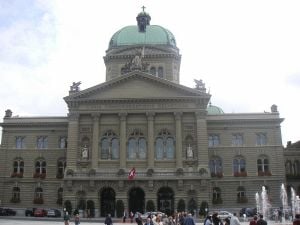
The Federal Constitution adopted in 1848 is the legal foundation of the Federation. It ensures the rights of individuals and citizen participation in public affairs, divides the powers between the Confederation and the cantons and defines federal jurisdictions. Under the Federal Constitution, there are three main governing bodies:[6] the bicameral parliament (legislative), the Federal Council (executive) and the Federal Court (judicial).
The parliament consists of two houses: the Council of States which has 46 representatives (two from each canton and one from each half-canton) who are elected under a system determined by each canton, and the National Council, which consists of 200 members who are elected under a system of proportional representation. Members of both houses serve for 4 years. When both houses are in joint session, they are known collectively as the United Federal Assembly. Through referenda, citizens may challenge any law passed by parliament and through initiatives, introduce amendments to the federal constitution, making Switzerland a direct democracy[citation needed].
Under the 1999 constitution, cantons hold all powers not specifically delegated to the federation.
The top executive body and collective Head of State is the Federal Council, a collegial body of seven members. Although the constitution provides that the Assembly elects and supervises the members of the Council for a four-year mandate, the latter (and its administration) has gradually assumed a pre-eminent role in directing the legislative process as well as executing federal laws. The President of the Confederation is elected from the seven to assume special representative functions for a one-year term, yet also maintains the role of his cabinet position.
From 1959 to December 2003, the four major parties were represented in the Federal Council according to the "magic formula", proportional to their representation in federal parliament: 2 Christian Democrats (CVP/PDC), 2 from the Social Democrats (SPS/PSS), 2 Liberal Democrats (FDP/PRD), and 1 from the Swiss People's Party (SVP/UDC). This traditional distribution of seats, however, is not backed up by any law, and in the 2003 elections to the Federal Council the CVP/PDC lost their second seat to the SVP/UDC, which became the strongest party in Switzerland's legislative the same year.
The function of the Federal Supreme Court is to hear appeals of cantonal courts or the administrative rulings of the federal administration. The judges are elected by the Federal Assembly for six-year terms.
Direct democracy
Swiss citizens are subject to three legal jurisdictions: the commune, canton and federal levels. The 1848 federal constitution defines a system of direct democracy (sometimes called half-direct democracy since it is complemented by the more commonplace institutions of a parliamentary democracy.) The instruments of Swiss direct democracy at the federal level, known as civil rights (droits civiques, Volksrechte), include the right to submit a constitutional initiative and a referendum, both of which may overturn parliamentary decisions.
By calling a federal referendum a group of citizens may challenge a law that has been passed by Parliament, if they can gather 50,000 signatures against the law within 100 days. If so, a national vote is scheduled where voters decide by a simple majority whether to accept or reject the law. Eight cantons together can also call a referendum on a federal law.
Similarly, the federal constitutional initiative allows citizens to put a constitutional amendment to a national vote, if they can get 100,000 voters to sign the proposed amendment within 18 months.[7] Parliament can complement the proposed amendment with a counter-proposal, with voters having to indicate a preference on the ballot in case both proposals are accepted. Constitutional amendments, whether introduced by initiative or in Parliament, must be accepted by a double majority of both the national popular vote and a majority of the cantonal popular votes.[8]
International institutions in Switzerland
An unusual number of international institutions have their seats in Switzerland, in part due to its policy of neutrality. The Red Cross was founded there in 1863 and still has its institutional centre in the country. Switzerland is not a member of the European Union; the Swiss people rejected membership in a referendum in the early 1990s. Switzerland was one of the last countries to join the United Nations, in 2002, even though Geneva is the second biggest centre for the United Nations after New York, and Switzerland was a founding member of the League of Nations.
Energy politics
Electricity generated in Switzerland is 40% from nuclear and 60% from hydroelectricity.
On 18 May, 2003, a popular initiative named Moratorium Plus asked about an extension of an existing law forbidding the building of new nuclear power plants. Both were turned down: Moratorium Plus by a margin of 41.6% for and 58.4% opposed, and Electricity Without Nuclear by a margin of 33.7% for and 66.3% opposed. The former ten-year moratorium on the construction of new nuclear power plants was the result of a citizens' initiative voted on in 1990 which had passed with 54.5% Yes vs. 45.5% No votes. There is currently talk of a new nuclear plant in the Canton of Bern.
The Swiss Federal Office of Energy (SFOE) is the office responsible for all questions relating to energy supply and energy use within the Federal Department of Environment, Transport, Energy and Communications (DETEC).See also SwissEnergy.[9]
Cantons (states)
Template:Switzerland Cantons Labelled Map
The Swiss Confederation consists of 26 cantons:
|
|
*These cantons are represented by only one councillor in the Council of States.
Their populations vary between 15,000 (Appenzell Innerrhoden) and 1,253,500 (Zürich), and their area between 37 km² (Basel-Stadt) and 7,105 km² (Graubünden). The Cantons comprise a total of 2,889 municipalities. Within Switzerland there are two enclaves: Büsingen belongs to Germany, Campione d'Italia belongs to Italy.
In a referendum held in the Austrian state of Vorarlberg on 11 May 1919 over 80% of those voting supported a proposal that the state should join the Swiss Confederation. However, this was prevented by the opposition of the Austrian Government, the Allies, Swiss liberals, the Swiss-Italians (persons of Swiss nationality who live in Italian Switzerland - see map) and the Romands (Swiss nationals living in the French-speaking regions of Switzerland - see map).[10]
Geography
With an area of 41,285 square kilometres (15,940 sq mi), Switzerland is a relatively small country. The population is about 7.4 million, resulting in an average population density of 182 people per square kilometre (472/sq mi).[11] However the more mountainous southern half of the country is far more sparsely populated than this statistic shows. The northern half has a somewhat greater density than the statistic shows, as it comprises more hospitable hilly terrain, partly forested and partly cleared, as well as several large lakes.
Switzerland comprises three basic topographical areas: the Swiss Alps, the Swiss plateau or "middleland", and the Jura mountains along the northwest border with France. The Alps are a high mountain range running across the central-south of the country. Among the high peaks of the Swiss Alps, the highest of which is the Dufourspitze at 4,634 metres (15,203 ft), are found countless valleys, many with waterfalls and glaciers. From these the headwaters of several major European rivers such as the Rhine, Rhône, Inn, Aare, and Ticino flow finally into the largest Swiss lakes such as Lake Geneva (Lac Leman), Lake Zürich, Lake Neuchâtel, and Lake Constance. The smaller lakes near the mountains tend to be a brilliant turquoise color, especially in the summer.
The most famous mountain is the Matterhorn (4478 m) in Kanton Wallis and Pennine Alps bordering Italy. The highest mountain, the Dufourspitze or Monte Rosa,is very close to the Matterhorn. The section of the Bernese Alps above the deep glacial Lauterbrunnen Valley containing 72 waterfalls is also well known for the Jungfrau (4,158 m), Mönch, Eiger group of peaks, and the many picturesque valleys in the region. In the southeast the long Engadin Valley, encompassing the St Moritz area in canton Graubünden, is also quite known and the highest peak here is the Piz Bernina (4,049 m).
The northern section and more populous part of the country is called the Middle Land. It has greater open and hilly landscapes, partly forested, partly open meadow, usually with grazing herds, or vegetables and fruits growing, but it can still be somewhat mountainous. There are large lakes found here and the biggest Swiss cities are in this area of the country. This section, particularly the west, is also referred to as the "Seeland" (the land of lakes) and the largest lake is Lake Geneva (Lac Léman in French), at the westernmost of Switzerland. The Rhone River is the main tributary to Lac Léman.
The Swiss climate is generally temperate, but can vary greatly between the localities, from glacial conditions on the mountain tops to the often pleasant Mediterranean climate at Switzerland's southern tip. Summer tends to be warm and humid at times with periodic rain so it is ideal for pastures and grazing. The winters in the mountains alternate with sun and snow, while the lower lands tend to be more cloudy and foggy in winter. A weather phenomenon known as the Föhn can occur at all times of the year, even in winter, and is characterized by a wind with warm Mediterranean air. The driest conditions persist in the southern valleys of the Wallis/Valais above which valuable saffron is harvested and many grapes are grown, Graubünden also tends to be drier in climate and slightly colder, yet with plentiful snow in winter. The wettest conditions persist in the high Alps and in the Ticino which has much sun yet heavy bursts of rain from time to time. The east tends to be colder than the west of Switzerland, yet anywhere up high in the mountains can experience a cold spell at any time of the year. Precipitation tends to be spread moderately throughout the year, with minor variations across the seasons depending on locale. Autumn frequently tends to be the driest season, yet the weather patterns in Switzerland can be highly variable from year to year, and very difficult to predict.
Switzerland's eco-systems can be particularly vulnerable, due to the many delicate valleys separated by high mountains, often forming unique ecologies. The mountainous regions themselves are also vulnerable, with a rich range of plants not found at other altitudes, and experience some pressure from visitors and grazing. The treeline in the mountains of Switzerland has retreated down 1000 ft over the years, largely due to herding and grazing pressures.
See also: Swisstopo topographical survey, List of lakes of Switzerland, List of rivers of Switzerland, List of mountain passes in Switzerland.
Economy
Switzerland has a prosperous and stable modern market economy, with a nominal per capita GDP that is higher than those of the big western European economies, United States and Japan, though on a PPP basis, it ranks tenth. The World Economic Forum's Global Competitiveness Report currently ranks Switzerland's economy as the most competitive in the world.[12] For much of the 20th century, Switzerland was the wealthiest country in Europe by a considerable margin. However, since the early 1990s it has suffered from slow growth and, in 2005, fell to fourth among European countries with populations above one million in terms of nominal Gross Domestic Product per capita behind Ireland, Denmark and Norway and to the tenth position in terms of Gross Domestic Product per capita at purchasing power parity (also behind the European countries Austria and Iceland; (see list). Switzerland is a member of the European Free Trade Association.
Banking, tourism, pharmaceuticals, and chemicals are very important industries in Switzerland. The manufacture of precision instruments for engineering is important, as is watchmaking, and the biological sciences industries as well enjoy a high place in the Swiss economy. The many international organizations in Switzerland contribute to the Swiss economy and labor market.
In recent years, the Swiss have brought their economic practices largely into conformity with those of the European Union in many ways, in an effort to enhance their international competitiveness. The economy has been growing most recently at around 3% per year. Full EU membership is a long-term objective of some in the Swiss government, but there is considerable popular sentiment against this supported by the conservative SVP party. The western French-speaking areas tend to be more pro-EU.
The government has established an Integration Office under the Department of Foreign and Economic Affairs. To minimise the negative consequences of Switzerland's isolation from the rest of Europe, Bern and Brussels signed seven agreements, called bilateral agreements, to further liberalise trade ties. These agreements were signed in 1999 and took effect in 2001. This first series of bilateral agreements included the free movement of persons. A second series covering nine areas was signed in 2004 and awaits ratification. The second series includes the Schengen treaty and the Dublin Convention. They continue to discuss further areas for cooperation. Switzerland most recently (2006) approved a billion euro supportative investment in the poorer eastern European countries in support of cooperation and positive ties to the EU as a whole. They have also been under EU and sometimes international pressure to open up their bank secrecy and to raise their tax rates into compliance with the EU. Preparatory discussions are being opened on four new areas: opening up the electricity market, participation in the European GPS system Galileo, cooperating with the European centre for disease prevention and recognising certificates of origin for food products. Switzerland voted against membership in the European Economic Area in December 1992 and has since maintained and developed its relationships with the European Union and European countries through bilateral agreements. Any internal debate on the subject has been suspended since March 2001, when the Swiss people refused in a popular vote to start accession negotiations with the EU. Both Switzerland and Norway have consistently voted against EU membership, although the votes have been very close.
Switzerland is heavily active in recycling and anti-littering bans and is one of the top recyclers in the world with roughly 98% of all recyclable items being recycled[citation needed]. In many places in Switzerland, household rubbish disposal is charged for. Garbage (except dangerous items, batteries etc.) will only be collected if it is in bags which either have a payment sticker attached, or in official bags with the surcharge paid when the bags are purchased. This gives a financial incentive to recycle as much as possible, since recycling is free[13] [1]. Swiss health officials and police often open up garbage for which the disposal charge has not been paid. They search for evidence such as old bills which connect the bag to the household/person they originated from. Fines for not paying the disposal fee range from 200-500 Francs ($165-$410 at April 2007 exchange rates).
Demographics

Switzerland lies at the crossroads of several major European cultures that have heavily influenced the country's languages and culture. Switzerland has four official languages: German (64%) in the north and centre; French (20.4%) to the west; Italian (6.5%) in the south; and Romansh (a Romance language), that is spoken locally by a small minority (< 0.5%) in the southeastern canton of Graubünden. (Some dialects of Franco-Provençal have speakers in rural communities in the region where French is spoken. This language has no legal status). The federal government is obliged to communicate in the four official languages. In the federal parliament, German, French, Italian and Romansh are the official languages and simultaneous translation is provided. The German spoken in Switzerland is predominantly a group of dialects collectively known as Swiss German, but written communication and broadcasts typically use Swiss Standard German. Similarly, there are some dialects in the other speaking part of Switzerland, called Swiss French and Ticinese (a dialect of Lombard). Also the official languages (German, French and Italian) borrow some terms not understood outside of Switzerland, i.e. terms from other languages (German Billette[15] from French), from similar term in another language (Italian azione used not as act but as discount from German Aktion). Learning one of the other national languages at school is obligatory for all Swiss, so most Swiss are supposed to be at least bilingual (in reality, many Swiss are more fluent in English than in their own country's other languages, particularly the German-speaking Swiss).
Resident foreigners and temporary foreign workers make up about 21% of the population. Most of these are from European Union countries (Italians being the largest group, at 4%), with smaller numbers from the rest of the world, including refugees from the former Yugoslavia (5%) and Turks (1%).
The country has seen growth in the population of Hmong, Lao and Vietnamese people, and also immigrants from Mexico and South America.
Religion
Switzerland has no country-wide state religion, though most of the cantons (except for Geneva and Neuchâtel) recognize official churches, in all cases including the Catholic Church and the Swiss Reformed Church, in some cantons also the Old Catholic Church and Jewish congregations.[16] These churches are financed by official taxation of adherents.
Christianity is the predominant religion of Switzerland, divided between the Catholic Church (41.8% of the population) and various Protestant denominations (40%). Immigration has brought Islam (4.3%) and Eastern Orthodoxy (1.8%) as sizeable minority religions.[17] The 2005 Eurobarometer poll[18] found 48% to be theist, 39% expressing belief in "a spirit or life force", 9% atheist and 4% agnostic.
The country is historically about evenly balanced between Catholic and Protestant, with a complex patchwork of majorities over most of the country. Some cantons, such as Appenzell, are even officially divided into Catholic and Protestant sections.[citation needed] The larger cities (Bern, Zürich and Basel) are predominantly Protestant. Central Switzerland, as well as the Ticino, is traditionally Catholic. The Swiss constitution of 1848, under the recent impression of the clashes of Catholic vs. Protestant cantons that culminated in the Sonderbundskrieg, consciously defines a consociational state, allowing the peaceful co-existence of Catholics and Protestants. A 1980 initiative calling for the complete separation of church and state was clearly rejected, with only 21.1% voting in support.
Culture
The culture of Switzerland is influenced by its neighbours and its international sentiment, but over the years a distinctive culture with some regional differences and an independent streak has developed. In particular, French-speaking regions have tended to orient themselves slightly more on French culture and tend to be more pro EU. Swiss German speaking areas may perhaps be seen more oriented on German culture and can be more traditionalist and neutralist, and Italian-speaking areas can have more of an Italian culture. A region may be in some ways strongly culturally connected to the neighbouring country that shares its language. The linguistically isolated Rhaeto-Romanic culture in the eastern mountains of Switzerland is also robust and strives to maintain its very rare linguistic tradition.
Many mountain areas have a strong highly energetic ski town culture in winter, and a hiking/wandering culture in summer. Some areas throughout the year have a recreational culture that caters to tourism, yet the quieter seasons are spring and autumn when there are fewer visitors and a higher ratio of Swiss. A traditional farmer and herder culture also predominates in many areas, and this connection to the land and agriculture is a strong glue holding all the Swiss together. Even though most no longer actually farm themselves, the small farms are omnipresent outside the cities, and as well many Swiss at least have a small garden plot or many window boxes with geraniums and other flowers.
A predominant cultural tendency in Switzerland is responsibility, safety, and respect for the rule of law with people even hesitant to cross the street unless the walk sign is green. Switzerland has traditionally had a very low rate and reputation for crime, yet many Swiss are concerned the crime rates have been slightly increasing with the large influxes of immigrants. On occasion, as reported in the newspapers, there are instances of a mugging, robbery, or attack on the streets of a big city, yet this is still quite rare, and even young women or children will walk unaccompanied through the forests or cities. Although crime rates in Switzerland are among the lowest in the world, there is some organized crime. The Swiss are well known for their affinity for cleanliness and punctuality, which is often the source of jokes. This reputation is not unfounded with Switzerland possessing one of the best road and public transportation networks in the world. Like many European nations the Swiss are big fans of football (soccer) and the national team or 'Nati' is widely supported. Swiss wrestling or "Schwingen" is an old tradition from the rural central cantons. However, motorsport has been banned in Switzerland ever since the 1955 Le Mans disaster.
Some remarkable monuments and places of Switzerland
- MattRiff.jpg
View of the Matterhorn from Riffelalp Valais
- Jungfrau461.jpg
Jungfraujoch
The United Nations in Geneva
- Matterhorn Mond.jpg
Gornergratbahn
The Jet d'eau in Geneva
See also
- 2004 in Switzerland, 2005 in Switzerland
- Communications in Switzerland
- Data codes for Switzerland
- Education in Switzerland
- Enlargement of the European Union - Switzerland
- Foreign relations of Switzerland
- List of cities in Switzerland
- List of Swiss people
- Military of Switzerland
- Public holidays in Switzerland
- Swiss citizenship
- Switzerland and the European Union
- Transport in Switzerland
- List of Swiss companies
- List of Switzerland-related topics
Notes
- ↑ The motto is traditional; it is not officially defined by the Swiss constitution or Swiss law. See Unus pro omnibus, omnes pro uno for more information.
- ↑ Switzerland Constitution, article 70, "Languages": (1) The official languages of the Federation are German, French, and Italian. Romansh is an official language for communicating with persons of Romansh language. (2) The Cantons designate their own official languages. In order to preserve harmony between linguistic communities, they respect the traditional territorial distribution of languages, and take into account the indigenous linguistic minorities.
- ↑ See Vladimir Lenin
- ↑ Let's Swallow Switzerland by Klaus Urner (Lexington Books, 2002).
- ↑ The Bergier Commission Final Report, page 117 http://www.uek.ch/en/.
- ↑ admin.ch - Political System
- ↑ Since 1999, an initiative can also be in the form of a general proposal to be elaborated by Parliament, but because it is considered less attractive for various reasons, this form of initiative has yet to find any use.
- ↑ I.e., a majority of 23 cantonal votes, because the result of the popular vote in the six traditional half-cantons each counts as half the vote of one of the other cantons.
- ↑ SwissEnergy
- ↑ unige.ch - Direct democracy in the world
- ↑ A zoomable map of Switzerland is available at either www.swissinfo-geo.org or www.swissgeo.ch; a zoomable satellite picture is at map.search.ch.
- ↑ World Economic Forum - Global Competitiveness Report
- ↑ BBC. Recycling around the world. 25 June 2005. Last accessed 24 April 2006.
- ↑ Swiss Federal Statistical Office, Federal Population Census 2000
- ↑ SBB: Billette - OnlineTicket
- ↑ state.gov - Switzerland
- ↑ CIA World Factbook section on Switzerland
- ↑ available at eu.int
 PDF
PDF
ReferencesISBN links support NWE through referral fees
- Clive H. Church (2004) The Politics and Government of Switzerland. Palgrave Macmillan. ISBN 0-333-69277-2.
- Dieter Fahrni (2003) An Outline History of Switzerland. From the Origins to the Present Day. 8th enlarged edition. Pro Helvetia, Zürich. ISBN 3-908102-61-8
- Historical Dictionary of Switzerland (2002-). Published electronically and in print simultaneously in three national languages of Switzerland.
- The Economist, "A special case: A survey of Switzerland". 14 February 2004.
- Swiss Statistics, official website of the Swiss Federal Statistical Office.
- CIA World Factbook - Switzerland
External links
Official Switzerland
- The Federal Authorities of the Swiss Confederation
- Your Gateway to Switzerland
- Maps from the Federal Office of Topography
History
- History of Switzerland: Primary Documents
- Historical Dictionary of Switzerland in German, French and Italian
- history-switzerland.geschichte-schweiz.ch
References
Media
- Neue Zürcher Zeitung, a Swiss daily newspaper in German
- Le Temps, a Swiss daily newspaper in French
- Corriere Del Ticino, a Swiss daily newspaper in Italian
- swissinfo - News + Infos in 9 languages
Tourism
- Switzerland Tourism, a national tourism organization
- List of Swiss municipalities, all about Swiss municipalities
- Pictures Switzerland
- Gay Times (UK) Entry on Switzerland
Energy
| |||||
Albania · Andorra · Armenia2 · Austria · Azerbaijan1 · Belarus · Belgium · Bosnia and Herzegovina · Bulgaria · Croatia · Cyprus2 · Czech Republic · Denmark3 · Estonia · Finland · France3 · Georgia1 · Germany · Greece · Hungary · Iceland · Ireland · Italy · Kazakhstan1 · Latvia · Liechtenstein · Lithuania · Luxembourg · Republic of Macedonia · Malta · Moldova · Monaco · Montenegro · Netherlands3 · Norway3 · Poland · Portugal · Romania · Russia1 · San Marino · Serbia · Slovakia · Slovenia · Spain3 · Sweden · Switzerland · Turkey1 · Ukraine · United Kingdom3 · Vatican City
1 Has majority of its territory in Asia. 2 Entirely in Asia but having socio-political connections with Europe. 3 Has dependencies or similar territories outside Europe.
Credits
New World Encyclopedia writers and editors rewrote and completed the Wikipedia article in accordance with New World Encyclopedia standards. This article abides by terms of the Creative Commons CC-by-sa 3.0 License (CC-by-sa), which may be used and disseminated with proper attribution. Credit is due under the terms of this license that can reference both the New World Encyclopedia contributors and the selfless volunteer contributors of the Wikimedia Foundation. To cite this article click here for a list of acceptable citing formats.The history of earlier contributions by wikipedians is accessible to researchers here:
The history of this article since it was imported to New World Encyclopedia:
Note: Some restrictions may apply to use of individual images which are separately licensed.
